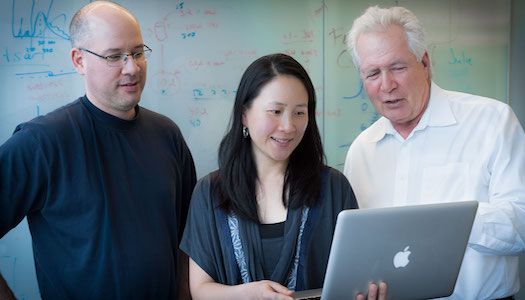Article
Cells Found in Mucosa Can Either Help Assist or Protect Against HIV
Author(s):
Fibroblasts help HIV while epithelial cells fight against it.

Pictured (left to right): Jason Neidleman, Nadia Roan, PhD, and Warner Greene, MD, PhD
A common cell found in the reproductive and intestinal tracts assists HIV to infect immune cells, researchers from the Gladstone Institutes and the University of California, San Francisco (UCSF) have discovered. Both institutions in San Francisco.
A protective layer of cells, called the mucosa, lines the human reproductive system and intestinal tract. Physical trauma and infections including certain sexually transmitted diseases are among reasons why the layer can be compromised. When that happens, HIV can make its way through and infect immune cells.
“We were interested in understanding how cells commonly found in mucosal tissues affect the ability of HIV to infect immune cells,” Nadia Roan, PhD, a visiting investigator at Gladstone and assistant professor UCSF, said in a news release.
Using a model of the mucosa and surround tissues, the researchers collaborated with colleagues in Europe to further understand the process.
As described by the team, a surprising finding was that connective tissue cells, called fibroblasts, play a key role in HIV’s ability to make its way past the protective layer. Just one way that the mucosal fibroblasts do this is through a process called trans-infection. During this process, the fibroblasts transport HIV to immune cells without actually becoming infected themselves.
“We discovered that, remarkably, mucosal fibroblasts could potently increase how well HIV infected immune cells,” Roan continued. “Knowing how this occurs at the molecular level can help us find new ways to fight the virus.”
Since the cervix, uterus, foreskin, male urethra, and intestines are prime portals for HIV entry, the researchers gathered mucosal fibroblasts from those areas. All of the tissues increased infection, and not just through trans-infection. These tissues also made the immune cells more prone to infection. The team described this fibroblast-mediated enhancement as “extremely potent.”

However, the researchers also found evidence showing a group of cells could help in the fight against HIV. Epithelial cells, also found in the mucosa, let helpful substances pass through while blocking harmful substances. The team observed that these cells secrete high levels of antiviral proteins—which is the opposite of what fibroblasts do.
“We believe that by secreting these antivirals and serving as physical barrier, the epithelial cells protect against infection,” explained first author, Jason Neidleman, a senior research associate at Gladstone.
With the combination of focusing on limiting fibroblast-mediated enhancement and utilizing the protective barrier of epithelial cells, this could become a novel HIV treatment approach.
Warner Green, MD, PhD, director of the Gladstone Institute of Immunology and Virology, concluded: “Our work suggests that breaches in the mucosa allows HIV to bypass an antiviral environment to access fibroblasts, which in turn boost levels of HIV infection in CD4 T cells. Knowing the specific cells that allow HIV to take advantage of breaches in our defenses will enable us to find better way to limit HIV transmission rates.”
Future research is already in the works for the Gladstone Institutes and UCSF team. The National Institutes of Health (NIH) will support the researchers to determine how the mucosal fibroblasts make the immune cells more likely to be infected by HIV.
The study, “Mucosal stromal fibroblasts markedly enhance HIV infection of CD4+ T cells,” was published in PLOS Pathogens.The news release was provided by Gladstone Institutes and the image was provided by Chris Goodfellow of Gladstone Institutes.
Related Coverage:
How Can We Get to HIV Remission?





